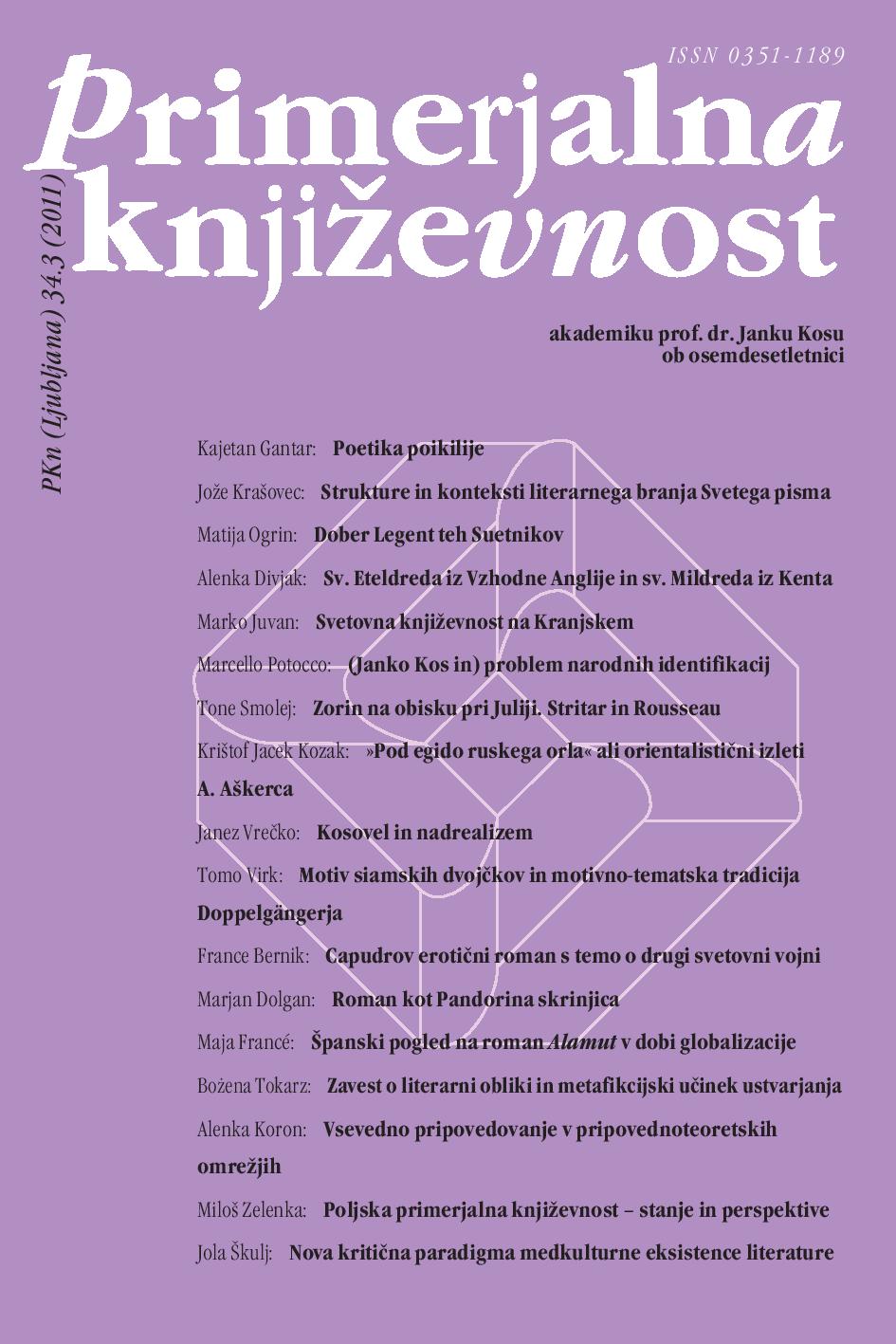The Novel as Pandora’s Box. Drago Jančar: I Saw Her That Night
Keywords:
Slovenian literature, literature and history, historical novel, Jančar, DragoAbstract
This article analyzes Drago Jančar’s novel To noč sem jo videl (I Saw Her That Night, 2010) and establishes that it functions as autonomous literary text, but paradoxically, at the same time, also outside literature. The novel is designed in a novella style because it contains five chapters that could be published as independent novellas. However, they use different means to connect the same literary characters and many events, which is why the sequence of the novellas functions as a novel. Each chapter is narrated by one of the characters involved in the developments. The subjective presentation of the developments is also enhanced by the fact that the novel does not have a framework story. This means that the author not only consciously omitted a specific narrative convention, but also that he omitted the main narrator that could evaluate all of the chapters and characters appearing in them, at least indirectly. Jančar’s novel is based on the conviction that it cannot contain any direct or indirect conceptual or ideological evaluation, even though the story increasingly forces the reader to do so towards the end of the novel. At the same time, the novel is a paraphrase of the Biblical parable of the lost son, but in Jančar’s novel it is not the problematic son that returns to his father, but an emancipated, fatal middle-class wife that returns to her tolerant husband, who forgives her for cheating on him even though he knows she does not love him and will probably continue cheating on him in the future. The seemingly happy reunion of the spouses is soon destroyed by their tragic end. This is also the core around which the entire story revolves. Therefore the novel’s composition is also a parallel retrospective and is concentric at the same time. Every character that narrates his or her chapter increasingly unveils a mysterious event from the past: the unexplained disappearance of the main character Veronica and her husband during the Second World War. The novel suggests to the reader that the disappearance has a political background, but in the end it surprisingly turns out that it involved gang rape and murder with a sexual motive, even though the perpetrators covered the crime up with political demagogy. Jančar’s novel involves certain features of a crime story and it distances itself from other genres. None of the bodies are found. The perpetrators remain free and unpunished because after the war they assumed power, which made it possible for them to cover up their crime and even forbid others from referring to it. Because of this the novel automatically makes the reader – who advocates for the dead to be buried in a civilized manner and for people to be able to express their opinions freely, and opposes manipulation of people – criticize the perpetrators and their military movement, ideology, and totalitarian regime after the war. The reader’s criticism is further increased by some extraliterary, historical facts, which the writer used in the novel in a modified form. Jančar’s novel is thus an autonomous literary work whose literary elements “force” the reader to cross the line of literary fiction and begin evaluating the extraliterary, historical developments in Slovenia during and after the Second World War. Some readers might become real-life detectives investigating real-life developments and thus track down the perpetrators and even find the dead bodies.References
Adair, Gilbert. Adzio und Tadzio. Wladyslaw Moes, Thomas Mann und Luchino Visconti: Der Tod in Venedig. Essay. Zürich: Epoca, 2002.
Baberowski, Jörg; Doering-Manteuffel, Anselm. Ordnung durch Terror. Gewaltexcesse und Vernichtigung im nationalsozialistischen und im stalinistischen Imperium. Bonn: Dietz, 2007 (2. izd.).
Blumenwitz, Dieter. Okupacija in revolucija v Sloveniji (1941−1946). Mednarodnopravna študija. Celovec: Mohorjeva družba, 2005.
Elm, Theo; Hiebel, Hans H. (ur.). Die Parabel. Parabolische Formen in der deutschen Dichtung des 20. Jahrhunderts. Frankfurt ob Majni: Suhrkamp, 1986.
Feldmann, Klaus. Tod und Gesellschaft. Sozialwissenschaftliche Thanatologie im Überblick. Wiesbaden: Verlag für Sozialwissenschaften, 2004.
Freud, Sigmund. Spisi o družbi in religiji. Ljubljana: Društvo za teoretsko psihoanalizo, 2007.
Grieser, Dieter. Mojstri in modeli. Zali deček v mornarsko modri obleki. Ljubljana: Delo [časnik], 4. avgust 1979, str. 24.
Hribar, Angelika. Rodbinska kronika Dragotina Hribarja in Evgenije Šumi. Knjižnica Kronike, časopisa za slovensko krajevno zgodovino, zvezek 11. Ljubljana: Zveza zgodovinskih društev Slovenije; Celje: Društvo Mohorjeva družba, 2008.
Jan, Ivan. Kokrški odred. Narodnoosvobodilni boj pod Karavankami I−III. Ljubljana: Partizanska knjiga 1980.
Jančar, Drago. To noč sem jo videl. Ljubljana: Modrijan, 2010.
Kronika. Časopis za slovensko krajevno zgodovino. Iz zgodovine gradu Strmol na Gorenjskem 54.2 (2006).
Kronika. Časopis za slovensko krajevno zgodovino. Rodbini Kalister in Gorup 58.1 (2010).
Michel-Thiriet, Philippe. Das Marcel Proust Lexikon. Frankfurt ob Majni: Suhrkamp, 1999.
Musek, Janek. Neznanke duha. Psihologija okultnega, paranormalnega in transcendentnega. Ljubljana: Educy, 1995.
Nusser, Peter. Der Kriminalroman. Stuttgart: Metzler, 2009 (4., dopol. izd.).
Schmid, Wolf. Elemente der Narratologie. Berlin: Gruyter, 2005.


